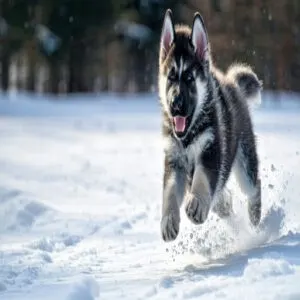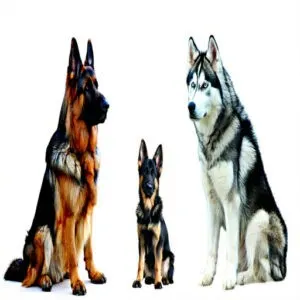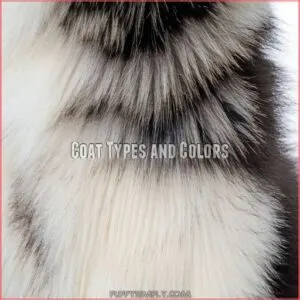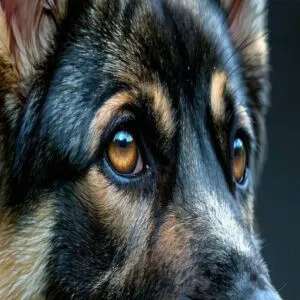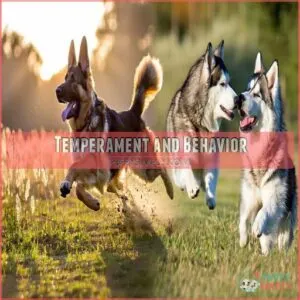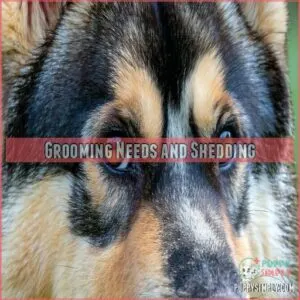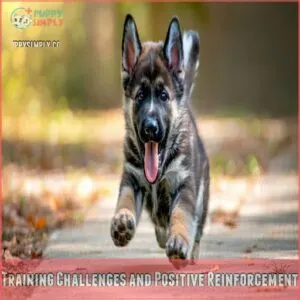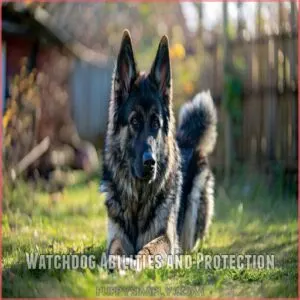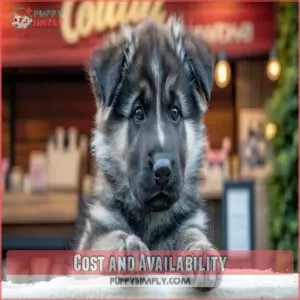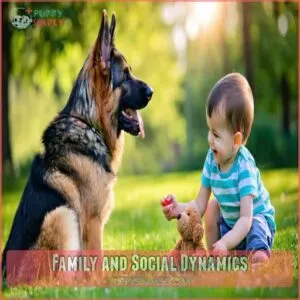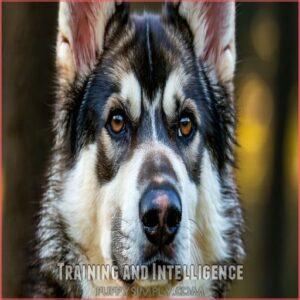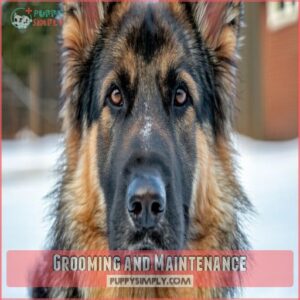This site is supported by our readers. We may earn a commission, at no cost to you, if you purchase through links.
 Looking for a loyal, energetic partner with the charm of a husky and the smarts of a German Shepherd? Meet the Gerberian Shepsky!
Looking for a loyal, energetic partner with the charm of a husky and the smarts of a German Shepherd? Meet the Gerberian Shepsky!
This husky German Shepherd mix is known for its striking appearance, intelligence, and loyal nature.
These dogs weigh between 35 to 88 pounds and sport a double coat that loves to shed, so get that brush ready!
They’re social butterflies with a need for 2-3 hours of exercise daily.
Perfect for active families, they thrive on mental stimulation and consistent training, even if they occasionally embrace their stubborn side.
Curious about what else makes them tick?
Table Of Contents
- Key Takeaways
- Origins and History
- Physical Characteristics
- Temperament and Behavior
- Care and Training
- Health Considerations
- Cost and Availability
- Family and Social Dynamics
- Training and Intelligence
- Grooming and Maintenance
- Is a Gerberian Shepsky Right for Me?
- Frequently Asked Questions (FAQs)
- Are German Shepherd and husky mix good dogs?
- What is a German Shepherd husky mix called?
- How much does a Shepsky cost?
- Is a shepsky rare?
- What are the best living conditions for a Shepsky?
- How long is the exercise duration needed daily?
- What nutritional needs do German Shepherd Husky mixes have?
- Are Shepskies prone to specific behavioral issues?
- How do Shepskies cope in hot climates?
- Conclusion
Key Takeaways
- You’ll need significant time for daily exercise and training; these are high-energy dogs.
- Their thick double coat means you’ll spend time grooming to manage shedding.
- They’re intelligent but can be stubborn, requiring patient, consistent training.
- Potential health issues include hip and elbow dysplasia and eye problems; regular vet checkups are essential.
Origins and History
You’ll find these incredible hybrid dogs gaining popularity since the 1990s, when breeders first started mixing German Shepherds and Siberian Huskies to create the perfect blend of smarts and stamina.
While they’re not officially recognized by the American Kennel Club, these pups have stolen hearts worldwide,
from the snowy streets of Canada to the sunny shores of Australia.
The Rise of Designer Breeds
Since the 1990s, designer breeds have taken the dog world by storm, and the Husky German Shepherd mix is no exception.
You’ll find these hybrid dogs gaining popularity across the US, Europe, and Australia, as pet lovers seek unique combinations of traits.
While some crossbreeds happen by chance, ethical breeders have intentionally developed these mixes to create companions that offer the best of both worlds.
Parent Breeds and Their Influence
Over generations, two remarkable breeds have shaped the Gerberian Shepsky’s unique character.
You’ll find the Siberian Husky’s free spirit and endurance blending with the German Shepherd’s loyalty and intelligence.
Think of it like mixing your favorite ice cream flavors – each parent breed brings its best traits to the table.
Their combined genetics create a dog that’s both adventurous and protective, making every Shepsky truly one-of-a-kind.
Development of The Gerberian Shepsky
The Gerberian Shepsky’s journey started in the 1990s during the designer breed boom in North America.
These striking hybrids emerged from both planned breeding programs and chance encounters between German Shepherds and Siberian Huskies.
While their exact origins remain a mystery, breeders aimed to combine the German Shepherd’s legendary intelligence with the Husky’s incredible stamina.
Today, you’ll find these beautiful dogs across the globe, from bustling American cities to Australian backyards.
Physical Characteristics
You’ll be amazed at how these gorgeous hybrids combine the best features of both parent breeds.
Their striking wolf-like appearance and impressive size range of 45-88 pounds are just a few of the things that make them so unique.
Their unique double coat comes in a stunning variety of colors, and you might even get lucky with those enchanting bi-colored eyes that’ll have everyone at the dog park doing double takes.
Size and Weight Range
While designer breeds can vary in size, your husky German shepherd mix will likely be a substantial companion.
Most adults range from 20-26 inches at the shoulder, with males typically larger than females.
Weight-wise, you’re looking at anywhere from 35-88 pounds – that’s quite a spread!
Think of them as falling between their parent breeds: generally bigger than a husky but smaller than a German shepherd.
Coat Types and Colors
Speaking of appearance, you’ll find your Husky German Shepherd mix sporting a luxurious double coat that can vary from medium to long length.
These beautiful hybrids showcase a stunning palette of colors: dark brown, black, gray, or light brown, often mixed with striking white patches.
You’ll notice unique markings that blend both parent breeds’ characteristics, making each pup truly one-of-a-kind in their coat pattern and coloring.
Facial Features and Eye Colors
Most Gerberian Shepskies sport distinctive facial features that’ll grab your attention right away. You’ll notice their striking wolf-like appearance, combining the Husky’s expressive face with the German Shepherd’s noble profile. Their eyes often steal the show, featuring colors that’ll make you do a double-take.
- Eye colors range from piercing blue to rich brown, with some pups showing heterochromia (different colored eyes)
- Strong, medium-length muzzles perfect for both work and play
- Alert, pointy ears that stand tall like their parent breeds
Temperament and Behavior
You’ll find your Husky German Shepherd mix is like having a furry superhero – loyal and protective as a German Shepherd, yet social and spirited as a Husky.
While they’ll keep you on your toes with their high energy and occasional stubbornness, you’ll never find a more devoted companion who’ll make you laugh with their goofy antics.
Loyalty and Affection
Your Gerberian Shepsky’s loyalty runs deep in their DNA, combining the German Shepherd’s unwavering devotion with the Husky’s friendly nature.
You’ll notice they follow you from room to room, keen to be part of your daily routine.
They’re not just pets – they’re family members who’ll shower you with affection through gentle nuzzles, playful interactions, and those adorable puppy eyes that melt your heart.
Energy Levels and Exercise Needs
While these devoted companions shower you with endless affection, be ready for their boundless energy.
Think of a Gerberian Shepsky as a four-legged athlete who needs 2-3 hours of daily exercise.
Between their Husky’s endless stamina and German Shepherd’s working drive, they’ll keep you moving.
Plan for long walks, running sessions, and interactive games – sitting still isn’t in their vocabulary.
Trainability and Socialization
Training a Gerberian Shepsky is like solving a puzzle – they’re incredibly intelligent but can be stubborn.
You’ll need patience and consistency to shape their behavior.
Early socialization helps them become well-adjusted adults who get along with everyone.
Start with basic obedience training and leash manners, then move to advanced commands.
These clever pups excel with positive reinforcement, responding best to treats and praise rather than harsh corrections.
Guard Dog Potential and Aggression
Most Gerberian Shepskies inherit strong protective instincts from their German Shepherd parent, making them naturally watchful.
Their guarding abilities can be attributed to their genetic predisposition to protective traits, similar to other breeds with protective aggression.
You’ll notice they’re quick to alert you to strangers, but they’re not typically aggressive without reason.
Their guarding abilities strike a sweet spot – they’ll keep an eye on things without going overboard.
With proper socialization, they’ll learn to distinguish between genuine threats and friendly faces.
Care and Training
You’ll need to roll up your sleeves for this energetic mix, as they’ll keep you busy with daily exercise, mental games, and grooming sessions that could fill a part-time job.
While training your Husky German Shepherd might test your patience (thanks to that stubborn Husky side), you’ll find that consistent positive reinforcement and early socialization turn this powerhouse pup into an incredibly well-behaved family member.
Exercise and Mental Stimulation
You’ll need to gear up for a powerhouse of energy with a Gerberian Shepsky.
These dogs pack both brains and brawn, requiring at least two hours of daily exercise to stay happy and balanced.
Mix up their routine with running, hiking, agility training, and puzzle toys to keep their clever minds engaged.
Without proper physical and mental workouts, they might channel that energy into redecorating your furniture!
Grooming Needs and Shedding
Let’s talk about the elephant in the room – these pups shed like there’s no tomorrow.
Their double coat, consisting of a wooly undercoat and a longer topcoat, is a significant contributor to this excessive shedding, especially during seasonal changes when the coat naturally sheds to regulate body temperature.
Your Husky German Shepherd mix has a thick double coat that requires daily brushing to manage shedding.
During seasonal changes, expect a "fur-nado" that’ll keep your vacuum busy.
Invest in quality deshedding tools, such as the Furminator, and schedule regular grooming sessions, including regular brushing with a slicker brush.
A proper grooming routine helps prevent matting and keeps their coat healthy.
Training Challenges and Positive Reinforcement
Beyond regular brushing sessions, training these clever pups takes strategy and patience.
While their intelligence shines through, the stubborn husky genes can make training feel like teaching a teenager who thinks they know everything.
Here’s what works best:
- Start with short, fun training bursts that keep their interest peaked
- Use high-value treats that motivate both breeds
- Stay consistent with commands and expectations
- Celebrate small wins to build confidence
Watchdog Abilities and Protection
Your Gerberian Shepsky’s watchdog abilities strike a unique balance between the Husky’s friendly nature and the German Shepherd’s protective instincts.
While they’ll definitely alert you to visitors with their impressive bark, their guarding style varies by personality.
Some become natural protectors, while others prefer to welcome strangers with a wagging tail.
Early training shapes whether they’ll be more watchdog or social butterfly.
This can be further enhanced with the right products like those found in a Husky Shepherd Guard Dog store Husky Shepherd gear.
Health Considerations
You’ll want to keep an eye on your Gerberian Shepsky’s health, as they can inherit common issues like hip dysplasia and eye problems from both parent breeds.
While they’re generally healthier than purebreds, you’ll need to schedule regular vet checkups to catch potential concerns early, especially since these playful pups are masters at hiding discomfort.
Common Health Issues and Concerns
While Gerberian Shepskies generally enjoy robust health thanks to hybrid vigor, they’re not immune to inherited conditions.
Think of them as genetic lottery tickets – you’ll want to stack the odds in their favor.
Here’s what to watch for:
- Eye issues like cataracts and progressive retinal atrophy
- Digestive problems including bloat and food sensitivities
- Endocrine concerns such as zinc deficiency and hypothyroidism
Regular vet check-ups and genetic testing can help catch these early.
Hip Dysplasia and Elbow Dysplasia
A Gerberian Shepsky‘s genetic makeup puts them at higher risk for joint problems that can affect their mobility and quality of life.
Understanding these conditions helps you catch early warning signs and take preventive steps.
| Condition | Early Signs | Prevention |
|---|---|---|
| Hip Dysplasia | Limping, Decreased activity | Regular exercise, Weight control |
| Elbow Dysplasia | Front leg lameness, Joint swelling | Proper nutrition, Avoid overexertion |
| Both Conditions | Difficulty rising, Stiffness | Regular vet checkups, Joint supplements |
| Genetic Testing | DNA screening available | Pre-breeding screening |
| Treatment Options | Surgery, Physical therapy | Pain management, Joint support |
Eye Problems and Vision Loss
Just as hip problems can impact mobility, eye conditions need attention in Shepskies.
Like their parent breeds, these pups face specific vision challenges that smart owners watch for:
- Progressive Retinal Atrophy (PRA) can gradually dim their world
- Cataracts might cloud their view, especially in older age
- Corneal dystrophy affects the eye’s surface, sometimes showing up early
Regular eye checks make all the difference – catch these issues early, and you’ll keep those beautiful eyes healthy longer.
Digestive Issues and Allergies
Like their parent breeds, Husky German Shepherd mixes can inherit sensitive stomachs and food allergies.
You’ll want to watch for signs like excessive scratching, digestive upset, or paw licking, which might signal food sensitivities.
Common allergens include chicken, beef, and grains. Adding digestive enzymes and probiotics to their diet can help maintain gut health and reduce tummy troubles. Keep a food diary to track any reactions.
Cost and Availability
You’ll find these stunning hybrid pups ranging from $400 to $1,500, with prices varying based on breeder reputation and your location.
Whether you’re checking local shelters or researching reputable breeders, you’ll want to factor in long-term costs like food, vet care, and training to make certain you’re ready for your new furry friend.
Purchase Price and Breeder Reputation
Reputable breeders of Husky German Shepherd mixes typically charge between $400 and $1,500, depending on the parents’ pedigree and location.
You’ll want to thoroughly research potential breeders, checking for health certifications, parent DNA testing, and positive reviews.
A trustworthy breeder will welcome your questions, provide detailed health records, and offer a written contract with health guarantees.
Red flags include unusually low prices or hesitation to show you the breeding facility.
Adoption Options and Rescue Organizations
Looking to adopt a Husky German Shepherd mix?
Many rescue networks across the country specialize in finding homes for these unique hybrids.
You’ll find them in breed-specific rescues, general shelters, and through fostering programs. Check local German Shepherd and Husky rescue organizations, as they often take in mixed breeds.
Additionally, online marketplaces offer a variety of products for Husky Shepherd Mix Adoption.
Online platforms like Petfinder and Adopt a Pet make it easier to connect with shelters housing these wonderful dogs.
Cost of Ownership and Long-term Expenses
Owning a Husky German Shepherd mix comes with significant ongoing costs that’ll impact your wallet.
You’re looking at monthly food expenses of $60-100 for high-quality kibble.
Plus $50-150 for routine vet checkups, which may include regular vaccinations costing $80-$150 for core vaccines.
Factor in grooming ($50-80 per session), training classes ($300-500), and pet insurance ($30-70 monthly).
Don’t forget emergency vet funds – these active pups can be adventure-seekers!
Family and Social Dynamics
You’ll find that your Husky German Shepherd mix can become the perfect family companion, blending the Husky’s friendly nature with the German Shepherd’s protective instincts.
While they’ll need early socialization to get along with other pets and kids,
you’ll be amazed at how these social butterflies can transform from playful goofballs to watchful guardians in a heartbeat.
Good With Children and Other Pets
Your Husky German Shepherd mix can be a fantastic family companion.
These dogs often show remarkable patience with children and form strong protective bonds.
While they might be a bit too energetic for toddlers, they’re generally gentle giants who understand they need to be careful around little ones.
Just remember their prey drive around smaller pets – your cat mightn’t appreciate their playful nature quite as much.
Socialization Needs and Introductions
Socializing a husky German shepherd mix takes patience and planning, especially if you want a well-mannered pup who gets along with everyone. Building on their natural friendliness with kids, these dogs need regular exposure to new experiences from an early age.
- Start with puppy classes to build confidence and social skills
- Schedule controlled meetups with friendly adult dogs
- Visit different environments like parks and pet stores regularly
Just remember, treats make everything better!
Territorial Behavior and Protection
Through the walls and across your home, a Husky German Shepherd mix keeps watchful eyes on their territory.
| Behavior Type | Indoor Setting | Outdoor Setting |
|---|---|---|
| Alert Level | Moderate barking | Vocal warnings |
| Response Time | Instant reaction | Quick patrolling |
| Aggression | Rarely shown | Situational |
| Watchfulness | Always alert | Territory focused |
Remember, while they’re natural protectors, early training helps balance their guardian instincts with friendly demeanor.
Training and Intelligence
You’ll find that training your Husky German Shepherd mix is like teaching a genius child who sometimes pretends not to hear you – they’re incredibly smart but can be wonderfully stubborn.
While they’ll pick up commands quickly thanks to their German Shepherd genes, you’ll need to channel their Husky-inherited independent streak with plenty of treats and positive reinforcement.
Trainability and Obedience
Most Husky German Shepherd mixes inherit a perfect blend of trainability and determination, making them quick learners with an independent streak. Training these spirited pups is like teaching a brilliant student who occasionally tests the boundaries.
As with other intelligent dog breeds easy to train, their high work ethic and keen instincts drive them to thrive on mental stimulation, which can be leveraged with positive reinforcement training methods**.
Here’s what you’ll notice during training:
- They respond exceptionally well to positive reinforcement
- Basic commands are mastered within days
- Consistency is your secret weapon
- Early socialization shapes their obedience foundation
Problem-Solving and Adaptability
Your Husky German Shepherd mix’s exceptional problem-solving abilities will keep you on your toes.
These clever canines excel at figuring out puzzle toys, escape routes, and even how to raid the treat jar when you’re not looking.
Their adaptability means they’ll thrive in various environments, from city apartments to country homes, as long as you provide enough mental stimulation and enrichment activities. Problem-solving abilities and adaptability are key traits.
Independent Thinking and Stubbornness
Inside the mind of a Gerberian Shepsky, you’ll find a fascinating mix of independence and determination.
These clever pups often display their stubborn streak, especially during training sessions.
Here’s what you’re likely to encounter:
- Selective listening when treats aren’t involved
- Creative problem-solving that sometimes means ignoring your commands
- That classic Husky "talk back" when they disagree with your requests
Remember, patience wins the game with these free spirits.
Grooming and Maintenance
You’ll need to roll up your sleeves for grooming your Husky German Shepherd mix, as their thick double coat needs serious attention to keep your home from turning into a winter wonderland of fur.
While these furry friends aren’t exactly low-maintenance in the grooming department, you’ll find that regular brushing sessions can become a special bonding time between you and your pup.
Coat Type and Grooming Needs
So, you’ve nailed training your smart husky shepherd mix? Great!
Now, let’s talk about their coat. Gerberian Shepskies have a double coat—think fluffy cloud meets rugged armor.
Brushing a couple of times a week keeps things tidy, preventing mats.
Regular baths aren’t always necessary; just use a good dog shampoo when needed. Their coat type makes for a pretty low-maintenance dog grooming routine, all things considered.
Shedding and Seasonal Changes
Ever notice how the seasons play tricks on your dog’s coat? For a German Shepherd Husky mix, shedding can be a game of "hair today, more tomorrow."
- Embrace brushing techniques to tackle the fuzz.
- Seasonal coat changes mean more grooming.
- Keep those allergy concerns in check with the right grooming tools.
Expect a cleanup challenge!
Bathing and Hygiene
Bathing your German Shepherd Husky mix is key to managing their dog odor.
While shedding makes you brush more, you only need to bathe them once a month, unless they roll in something nasty.
Use dog shampoo to avoid skin irritation.
After a bath, thoroughly dry them with a towel or hairdryer to keep that lovely coat care fresh.
Is a Gerberian Shepsky Right for Me?
Thinking about bringing home a Gerberian Shepsky?
You’ll need a sturdy leash, some open space, and loads of energy to keep up.
These guys might just outpace your morning coffee!
Lifestyle Considerations and Space
Thinking about a Gerberian Shepsky?
These large breed dogs thrive with space to roam, but don’t worry if you’re in an apartment.
What’s important is access to a yard or nearby parks to meet their space needs.
An active lifestyle helps.
Remember, their exercise needs fit best in a roomy living environment with a backyard for ideal happiness.
Time Commitment and Exercise Needs
Balancing time with a Gerberian Shepsky can feel like taming a wild storm! These high-energy dogs aren’t for the faint-hearted, requiring daily walks and playtime like clockwork.
To help manage their strength and make sure they’ve a safe and comfortable experience, consider investing in a quality harness specifically designed for their breed.
Here’s a quick guide:
- Walk: At least twice a day.
- Play: Engage in active games.
- Train: Spend quality time training and stimulating their powerful minds.
Personality Match and Compatibility
So, you’ve weighed the time commitment—now, let’s see if a Gerberian Shepsky fits your personality. Think of it like choosing a new friend. A Gerberian Shepsky’s lively and affectionate nature makes them a great companion for active families, requiring proper training and socialization.
| Owner Personality | Activity Level | Living Space | Pet Experience |
|---|---|---|---|
| Active, Outgoing | High | Large Yard | Extensive |
| Relaxed, Calm | Moderate | Apartment, House | Limited |
| Patient, Experienced | Moderate to High | House with Yard | Moderate |
| Energetic, Adventurous | High | Large Property | Extensive |
Does this chart reflect you? A good match means a happy pup—and a happy owner!
Frequently Asked Questions (FAQs)
Are German Shepherd and husky mix good dogs?
Ever wonder if a German Shepherd and Husky mix makes a good dog? Absolutely, they do!
They’re intelligent, loyal, and energetic, blending the best qualities of both breeds.
With proper training, they’re fantastic companions and protectors. German Shepherd and Husky mix
What is a German Shepherd husky mix called?
A German Shepherd and Husky mix is called a Gerberian Shepsky.
This designer breed combines the intelligence and loyalty of the German Shepherd with the stamina and friendliness of the Husky, making it a unique companion.
How much does a Shepsky cost?
Buying a Shepsky can set you back anywhere from $400 to $1,200, depending on the breeder’s reputation, location, and the pup’s pedigree. Remember, adoption is a cost-effective and rewarding option too!
Is a shepsky rare?
Think of it like a rare gemstone: Shepskies aren’t exactly common, but they’re not unicorns either.
You’ll find them, but they might require some searching.
Their popularity means they aren’t exceptionally rare.
What are the best living conditions for a Shepsky?
A Shepsky thrives in a spacious home with a big yard for play.
They need daily exercise, mental stimulation, and love having a family that’s active and engaging, just like having a workout buddy who never skips leg day!
How long is the exercise duration needed daily?
Coincidentally, you and your Shepsky need an active lifestyle.
Aim for at least an hour of daily exercise, mixing walks, runs, and playtime.
It keeps those brains busy and bodies fit, just what’s needed for a happy pup!
What nutritional needs do German Shepherd Husky mixes have?
Your German Shepherd Husky mix thrives on a high-protein diet.
25% in grain-based food and 30% in grain-free.
Balanced meals with premium dry kibble or quality wet food help fuel that endless energy and adventurous spirit.
Are Shepskies prone to specific behavioral issues?
Like trying to keep a lid on a jack-in-the-box, Shepskies can face issues with barking, stubbornness, and a high prey drive.
Socialization and training are key to keeping these intelligent, energetic dogs well-behaved.
How do Shepskies cope in hot climates?
Shepskies can handle hot climates better than you’d think, thanks to their double coats that insulate them.
Just make sure they’ve plenty of water and shade, and avoid strenuous activity during peak heat.
Conclusion
Worried about handling a husky German Shepherd mix’s energy? Don’t be!
With the right exercise and training, they’re incredibly rewarding companions.
Their charm lies in their loyalty and the unique blend of traits from both parent breeds.
You’ll need a brush, dedication to daily walks, and plenty of love for this intelligent hybrid.
If you’re ready for adventure and a bit of doggy wit, the Gerberian Shepsky might just be your perfect match!

